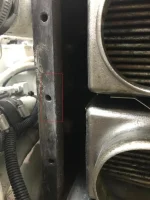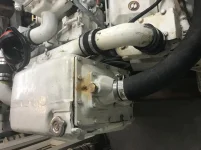MVCaprice
Well-known member
- Joined
- Aug 16, 2012
- Messages
- 663
- Status
- OWNER - I own a Hatteras Yacht
- Hatteras Model
- 61' MOTOR YACHT (1980 - 1985)
Recently I had the heat exchangers out of our 12v71's for cleaning. When I put the HE's back in I changed the glands, orings and all gaskets. After running a bit i started to see salt weeping coming through the orings and glands on the HE discharge side on the port engine at
1) I somehow have the wrong O-rings installed. I called pc industries and had them look at the diameter of the Detroit orings vs the aftermarket orings and they are the same and i used the same part number on the other side. The oring seal p/n i am using is
2) The exhaust sprayer may be clogged which is creating excessive pressure in the heat exchanger. I haven't looked but have read on this forum that they need to be cleaned from time to time.
I would suspect something else in the cooling system but the flow of water is salt only and i didn't have any other issues with the cooling system that i could tell. However I haven't checked the coolant yet so i need to look a little closer.
Anyone have any experience with a similar issue?
higher rpm.
In thinking about this problem and possible causes I am thinking there might be a couple scenarios that i could up against:1) I somehow have the wrong O-rings installed. I called pc industries and had them look at the diameter of the Detroit orings vs the aftermarket orings and they are the same and i used the same part number on the other side. The oring seal p/n i am using is
5167746
.2) The exhaust sprayer may be clogged which is creating excessive pressure in the heat exchanger. I haven't looked but have read on this forum that they need to be cleaned from time to time.
I would suspect something else in the cooling system but the flow of water is salt only and i didn't have any other issues with the cooling system that i could tell. However I haven't checked the coolant yet so i need to look a little closer.
Anyone have any experience with a similar issue?



